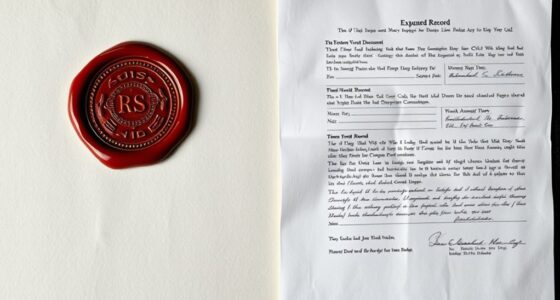To understand a docket sheet like a lawyer, start by reviewing the case chronology, noting dates of filings, hearings, and decisions. Learn common abbreviations such as “MTN” for motion or “JUD” for judgment, which quickly reveal what’s happening. Pay attention to patterns and procedural steps to gauge case status. With this knowledge, you can better analyze the case’s progress and upcoming actions. Keep exploring, and you’ll gain even more skills to navigate these legal tools effectively.
Key Takeaways
- Understand the case chronology by reviewing entries sorted by date to see case progression.
- Familiarize yourself with common legal abbreviations to interpret case actions quickly.
- Identify key case events such as filings, motions, hearings, and decisions for context.
- Recognize patterns like delays or repeated motions to assess case status and planning needs.
- Use the docket sheet to track upcoming court dates and prepare effective case management strategies.

Understanding a docket sheet is essential for traversing the legal landscape effectively, whether you’re a lawyer, a paralegal, or someone involved in a case. It serves as a chronological record of all case activities, providing a timeline that outlines every event, motion, and court date. When you look at a docket sheet, your first goal is to grasp the case chronology — the sequence of filings, hearings, and decisions that shape the case’s progression. Recognizing this timeline helps you understand where the case currently stands and what steps are upcoming. As you review the document, you’ll notice a variety of legal abbreviations that are shorthand for common court actions and filings. These abbreviations, like “MTN” for motion or “RJN” for response to a judgment notice, streamline the record but can be confusing if you’re unfamiliar with them. Learning what these abbreviations mean is key to quickly interpreting the docket without constantly cross-referencing legal dictionaries.
The docket sheet is typically organized with entries listed by date, so starting from the top, you can trace how the case has evolved over time. Each entry usually includes the date, case number, the party involved, and a brief description of the action taken. For example, an entry labeled “Complaint Filed” indicates the initial filing that starts the case, while “Summary Judgment Motion” shows a significant procedural step. Understanding these entries in context allows you to see patterns, such as delays, continuances, or repeated motions, helping you anticipate future court dates or strategic moves.
Legal abbreviations are particularly important because they condense complex actions into brief codes. For instance, “OSC” might stand for “Order to Show Cause,” indicating a hearing scheduled to address a specific issue. Recognizing these abbreviations and what they stand for enables you to read the docket swiftly and accurately. It’s like learning a shorthand language that reveals the story behind each case activity. By combining your knowledge of case chronology with a solid grasp of legal abbreviations, you get a clearer picture of the case’s history, current status, and likely future developments. This understanding empowers you to prepare better, whether you’re drafting documents, coordinating with clients, or strategizing for court. Additionally, understanding the contrast ratio of a projector can help you evaluate how well the images will appear in your viewing environment, which is especially useful when creating a home cinema setup. Ultimately, mastering these elements transforms the docket sheet from a confusing list of entries into a valuable tool for traversing the legal process effectively.
Frequently Asked Questions
How Do I Access a Docket Sheet Online?
To access a docket sheet online, start by visiting the court’s official website or a trusted legal database. Search using the case number or party names to find relevant court case timelines and filing procedures. Many courts provide free access, while others might require a small fee. Once you locate the case, you can view or download the docket sheet, giving you detailed information about filings, hearings, and case progress.
What Do Abbreviations on a Docket Sheet Mean?
Deciphering legal abbreviations and court symbols can feel like cracking a secret code used by the universe itself! When you see legal abbreviations, they’re shortcuts for longer legal terms, like “pltf” for plaintiff or “dft” for defendant. Court symbols often represent actions or statuses, such as a checkmark for completion. Learning these helps you quickly understand case progress and legal jargon, making the docket sheet your new best friend.
How Often Is a Docket Sheet Updated?
You should check the docket sheet regularly because it updates with new case filings and court deadlines. Updates happen frequently, often daily or weekly, depending on the court’s schedule. Staying current guarantees you’re aware of any changes or upcoming deadlines that could impact your case. By reviewing the docket sheet often, you keep track of all relevant case activity and avoid missing important court events or filings.
Can I Interpret Legal Jargon on a Docket Sheet?
They say, “A picture is worth a thousand words,” but sometimes legal jargon on a docket sheet can feel like a foreign language. Don’t worry—you can interpret legal terminology by familiarizing yourself with court procedures and common terms. With some practice, you’ll start understanding legal language, making it easier to follow cases. Remember, patience and research are your best tools in decoding court documents.
What Should I Do if I Find Errors on a Docket Sheet?
If you find errors on a docket sheet, you should act promptly. First, review the common errors, like misspelled names or incorrect dates. Then, follow the correction process by notifying the court clerk or relevant authority. Provide supporting documentation if needed, and request the correction. Staying proactive helps make certain the docket sheet reflects accurate case information, reducing confusion and avoiding potential legal issues down the line.
Conclusion
Now that you know how to read a docket sheet, you’re like a detective uncovering hidden details in a case. With practice, you’ll spot important information quickly and confidently, just as a seasoned lawyer does. Remember, each line is a clue leading to the bigger picture. Keep studying, stay curious, and soon you’ll navigate docket sheets effortlessly—like a master chess player anticipating every move on the board.









